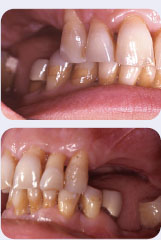
Full mouth rehabilitation—implant-supported, screw-retained prostheses
Selection of a type of implant-supported prosthesis requires comprehensive understanding of biological and mechanical (prosthetic) limitation of each prosthetic design. Number and length of implants, distribution of implants, available interarch space, quality and type of underlying bone, presence of parafunctional habit, maintainability, and retrievability are the factors influencing this decision-making process.
CASE STORY
A 43-year-old female concerned with deteriorating dental condition presents for comprehensive treatment. The patient was mainly concerned with inability to chew due to the lack of maxillary posterior teeth. She expressed a strong interest in dental implant therapy due to her unsuccessful previous experience with a maxillary removable partial denture.
Figure 1: Pretreatment front view.

Figures 2 and 3: Pretreatment right and left views.

LEARNING GOALS AND OBJECTIVES
- I dentify the advantages and disadvantages of screw-retained implant-supported fixed partial dentures.
- I dentify the indications for screw-retained implant-supported fixed partial dentures.
Medical History
- No significant findings
Dental History
- The patient reported a long-standing history of periodontal disease and loss of maxillary posterior teeth due to the severe bone loss. Upon the loss of posterior occlusion, a previous dentist provided a transitional partial denture, but the patient could not tolerate the prosthesis.
Clinical Findings/Problem List
- Missing maxillary premolars (tooth numbers 4, 5, 12, 13), molars (tooth numbers 1, 2, 3, 14, 15, 16), and mandibular molars (tooth numbers 18, 19, 30, 31)
- Supraerupted mandibular molars
- Defective restorations
- Caries
- Generalized 3-5 mm recession
- Suppuration in mandibular anterior region
- Wear facets (abrasion, attrition, and abfraction)
- Generalized clinical mobility ranging from 2+ to 3
- Limited posterior interarch space due to supraeruption of remaining mandibular posterior teeth
- Generalized >50% attachment loss
- Localized >70% attachment loss in mandibular anterior and molar regions
Diagnosis
- Generalized chronic moderate to severe periodontitis
- Caries
- Occlusal discrepancy
- Partial edentulism
- Defective restorations
- Limited posterior interarch space due to supraeruption of remaining mandibular posterior teeth
Clinical Decision-Making Determining Factors
- Success of implant-supported prostheses is based on dynamic multifactorial issues. During treatment planning, high risk factors, such as insufficient number of implants relative to arch length, shorter length of implants, poorly distributed implants, limited interarch space, poor implant-to-restoration ratio, poor quality and type of underlying bone, and presence of parafunctional habit drive clinicians to incorporate retrievable elements to be part of the prosthesis design. Screw-retain/>
Stay updated, free dental videos. Join our Telegram channel

VIDEdental - Online dental courses


